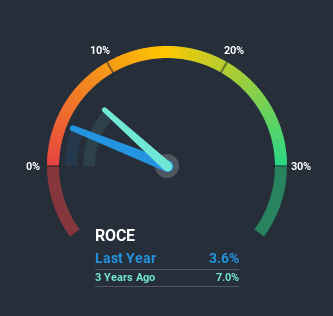- Israel
- /
- Specialty Stores
- /
- TASE:DRAL
The Trends At Dor Alon Energy In Israel (1988) (TLV:DRAL) That You Should Know About

What trends should we look for it we want to identify stocks that can multiply in value over the long term? In a perfect world, we'd like to see a company investing more capital into its business and ideally the returns earned from that capital are also increasing. Basically this means that a company has profitable initiatives that it can continue to reinvest in, which is a trait of a compounding machine. In light of that, when we looked at Dor Alon Energy In Israel (1988) (TLV:DRAL) and its ROCE trend, we weren't exactly thrilled.
What is Return On Capital Employed (ROCE)?
For those that aren't sure what ROCE is, it measures the amount of pre-tax profits a company can generate from the capital employed in its business. The formula for this calculation on Dor Alon Energy In Israel (1988) is:
Return on Capital Employed = Earnings Before Interest and Tax (EBIT) ÷ (Total Assets - Current Liabilities)
0.036 = ₪134m ÷ (₪5.1b - ₪1.4b) (Based on the trailing twelve months to September 2020).
Thus, Dor Alon Energy In Israel (1988) has an ROCE of 3.6%. Ultimately, that's a low return and it under-performs the Specialty Retail industry average of 6.5%.
Check out our latest analysis for Dor Alon Energy In Israel (1988)

While the past is not representative of the future, it can be helpful to know how a company has performed historically, which is why we have this chart above. If you want to delve into the historical earnings, revenue and cash flow of Dor Alon Energy In Israel (1988), check out these free graphs here.
The Trend Of ROCE
In terms of Dor Alon Energy In Israel (1988)'s historical ROCE movements, the trend isn't fantastic. Around five years ago the returns on capital were 8.0%, but since then they've fallen to 3.6%. And considering revenue has dropped while employing more capital, we'd be cautious. This could mean that the business is losing its competitive advantage or market share, because while more money is being put into ventures, it's actually producing a lower return - "less bang for their buck" per se.
On a side note, Dor Alon Energy In Israel (1988) has done well to pay down its current liabilities to 28% of total assets. So we could link some of this to the decrease in ROCE. What's more, this can reduce some aspects of risk to the business because now the company's suppliers or short-term creditors are funding less of its operations. Some would claim this reduces the business' efficiency at generating ROCE since it is now funding more of the operations with its own money.
The Bottom Line
We're a bit apprehensive about Dor Alon Energy In Israel (1988) because despite more capital being deployed in the business, returns on that capital and sales have both fallen. The market must be rosy on the stock's future because even though the underlying trends aren't too encouraging, the stock has soared 155%. In any case, the current underlying trends don't bode well for long term performance so unless they reverse, we'd start looking elsewhere.
One more thing: We've identified 3 warning signs with Dor Alon Energy In Israel (1988) (at least 1 which is a bit unpleasant) , and understanding them would certainly be useful.
While Dor Alon Energy In Israel (1988) isn't earning the highest return, check out this free list of companies that are earning high returns on equity with solid balance sheets.
When trading Dor Alon Energy In Israel (1988) or any other investment, use the platform considered by many to be the Professional's Gateway to the Worlds Market, Interactive Brokers. You get the lowest-cost* trading on stocks, options, futures, forex, bonds and funds worldwide from a single integrated account. Promoted
New: Manage All Your Stock Portfolios in One Place
We've created the ultimate portfolio companion for stock investors, and it's free.
• Connect an unlimited number of Portfolios and see your total in one currency
• Be alerted to new Warning Signs or Risks via email or mobile
• Track the Fair Value of your stocks
This article by Simply Wall St is general in nature. It does not constitute a recommendation to buy or sell any stock, and does not take account of your objectives, or your financial situation. We aim to bring you long-term focused analysis driven by fundamental data. Note that our analysis may not factor in the latest price-sensitive company announcements or qualitative material. Simply Wall St has no position in any stocks mentioned.
*Interactive Brokers Rated Lowest Cost Broker by StockBrokers.com Annual Online Review 2020
Have feedback on this article? Concerned about the content? Get in touch with us directly. Alternatively, email editorial-team (at) simplywallst.com.
About TASE:DRAL
Dor Alon Energy In Israel (1988)
Develops, constructs, and operates fueling complexes and commercial centers in Israel.
Proven track record and fair value.
Similar Companies
Market Insights
Community Narratives



